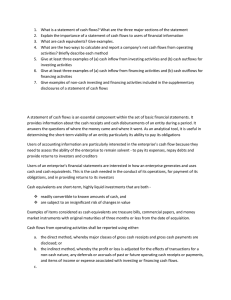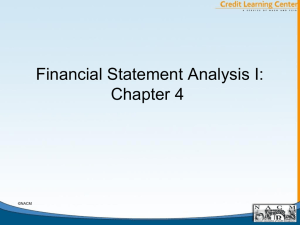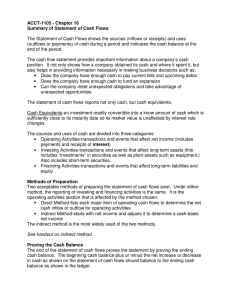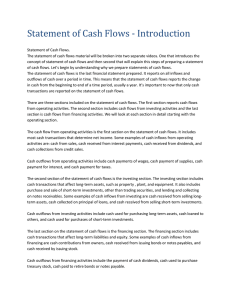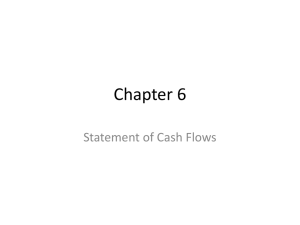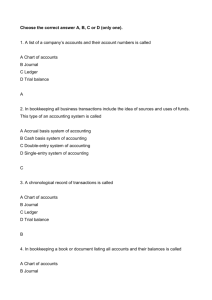Statement of Cash Flows Lecture Notes
advertisement
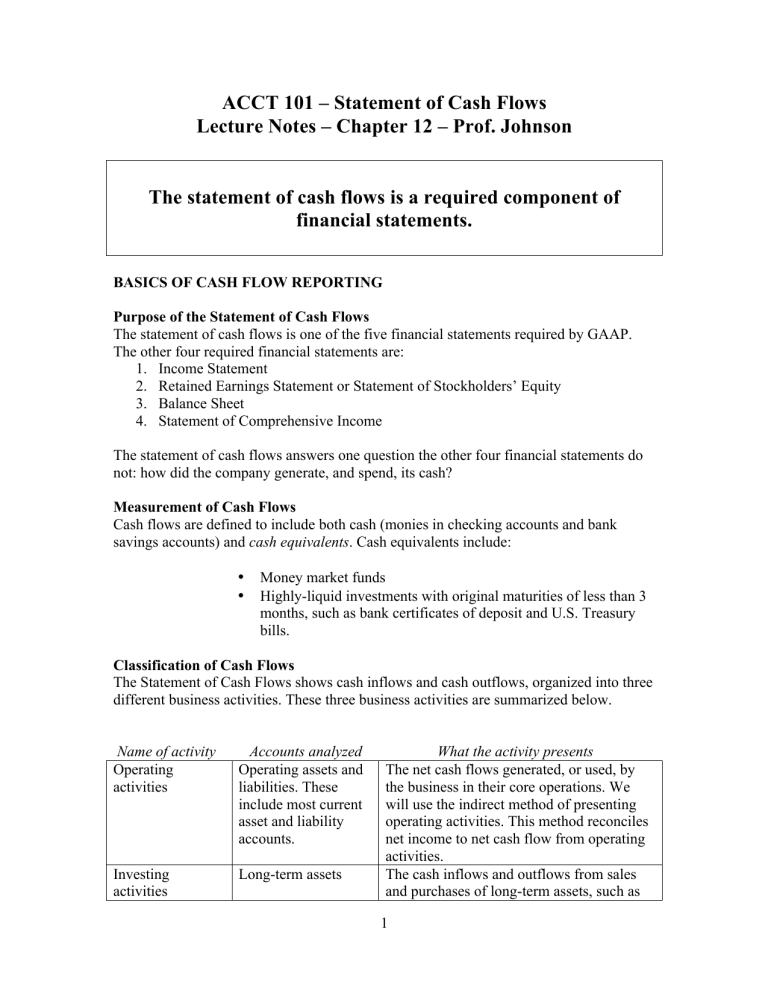
ACCT 101 – Statement of Cash Flows Lecture Notes – Chapter 12 – Prof. Johnson The statement of cash flows is a required component of financial statements. BASICS OF CASH FLOW REPORTING Purpose of the Statement of Cash Flows The statement of cash flows is one of the five financial statements required by GAAP. The other four required financial statements are: 1. Income Statement 2. Retained Earnings Statement or Statement of Stockholders’ Equity 3. Balance Sheet 4. Statement of Comprehensive Income The statement of cash flows answers one question the other four financial statements do not: how did the company generate, and spend, its cash? Measurement of Cash Flows Cash flows are defined to include both cash (monies in checking accounts and bank savings accounts) and cash equivalents. Cash equivalents include: • • Money market funds Highly-liquid investments with original maturities of less than 3 months, such as bank certificates of deposit and U.S. Treasury bills. Classification of Cash Flows The Statement of Cash Flows shows cash inflows and cash outflows, organized into three different business activities. These three business activities are summarized below. Name of activity Operating activities Accounts analyzed Operating assets and liabilities. These include most current asset and liability accounts. Investing activities Long-term assets What the activity presents The net cash flows generated, or used, by the business in their core operations. We will use the indirect method of presenting operating activities. This method reconciles net income to net cash flow from operating activities. The cash inflows and outflows from sales and purchases of long-term assets, such as 1 Financing activities Long-term liabilities and stockholders’ equity. equipment, patents, and long-term investments. The cash inflows and outflows from issuance of debt; repayment of debt; issuance of stocks; dividends paid; and stock repurchases. Noncash Investing and Financing Activities Businesses sometime engage in transactions not affecting cash. For example, a business can purchase equipment by issuing a long-term note payable to the vendor. In this case, cash is not affected, and this transaction would not be reported in the body of the statement of cash flows. This transaction, referred to as a noncash investing and financing activity, would instead be disclosed either at the bottom of the statement of cash flows or in a note to the financial statements. CASH FLOWS FROM OPERATING ACTIVITIES Using the indirect method of reporting operating activities Nearly all companies report operating activities using the indirect method. This is because the indirect method is easier to compute—although you may disagree after completing the homework! (In class, we will go over a skeleton format that will be much easier to remember than the more formal one shown below.) The following template should prove helpful to you in preparing the operating activities of the statement of cash flows using the indirect method. Net Income Adjustments to reconcile net income to net cash provided by operating activities Decrease in operating assets ** Increase in operating liabilities + Increase in operating assets ** Decrease in operating liabilities + Depreciation Expense Loss on sale of assets or debt retirement Gain on sale of assets or debt retirement Net Cash Provided by Operating Activities $XXX X X (X) (X) X X (X) $XXXX **Examples: A/R, Inventory, prepaid assets, and trading securities. + Examples: A/P, accrued liabilities, and unearned rent; excludes dividends payable. If the indirect method is used, income taxes paid and interest paid must be disclosed in a footnote to the financial statements. 2 For example, assume Michelle Company reported the following for its most recent fiscal year: Net income, $200,000 Depreciation expense, $50,000 Increase in accounts receivable, $10,000 Decrease in merchandise inventory, $2,000 Increase in prepaid expenses, $1,000 Decrease in accounts payable, $9,000 Increase in wages payable, $3,000 Loss on sale of equipment, $1,000 The operating activities would report the following, using the indirect method: Cash flows from operating activities Net income Adjustments to reconcile net income to net cash provided by operating activities Increase in accounts receivable Decrease in merchandise inventory Increase in prepaid expenses Decrease in accounts payable Increase in wages payable Depreciation expense Loss on sale of equipment Net cash provided by operating activities $200,000 (10,000) 2,000 (1,000) (9,000) 3,000 50,000 1,000 CASH FLOWS FROM INVESTING ACTIVITIES Investing activities include cash inflows from: • Sale of long-term assets • Sale of investments (except trading securities) • Collections of notes receivable Investing activities include cash outflows from: • Purchase of long-term assets • Purchase of investments (except trading securities) • Loaning cash to others Obtaining the data for the investing activities section involves three steps: 1. Calculate the increase or decrease in the long-term asset accounts 2. Reconstruct the changes in the accounts 3. Report their effects in the investing activities 3 $236,000 As an example, assume the balance of Equipment for Michelle Company was $100,000 at the beginning of the year, and $120,000 at the end of the year. We can say Equipment increased by $20,000 during the year. However, a detailed reconstruction of Equipment revealed the following: Equipment, beginning of year Purchases of equipment Sales of equipment Equipment, end of year $100,000 30,000 (10,000) $120,000 The equipment sold had an original cost of $10,000 and accumulated depreciation of $4,000, so its book value was $6,000. Assuming the equipment was sold for $5,000, a loss of $1,000 on sale of equipment was incurred. The investing activities section for Michelle Company would report the following: Cash flows from investing activities Cash received from sale of equipment Cash paid for purchase of equipment Net cash used in investing activities $5,000 (30,000) (25,000) The loss on sale of equipment of $1,000 would be added to net income in operating activities. CASH FLOWS FROM FINANCING ACTIVITIES Financing activities include cash inflows from: • Issuing stock • Issuing debt Financing activities include cash outflows from: • Purchasing treasury stock • Retiring stock by purchase • Debt payments • Dividend payments For example, if a company issued stock for $50,000 but repaid debt of $20,000, the financing activities section would report the following. Cash flows from financing activities Cash received from issuing stock Cash paid to retire debt Net cash provided by financing activities 4 $50,000 (20,000) 30,000 PROVING CASH BALANCES After preparing the operating, investing and financing activities of the statement of cash flows, one final step remains. We must report the beginning and ending balances of cash and cash equivalents, and prove that the net change in cash is explained by summing the operating, investing, and financing activities. Assume the beginning of year cash balance for Michelle Company was $100,000, and the end of year cash balance was $341,000. The net increase in cash would be $241,000. Michelle Company’s statement of cash flow, once completed, would appear as follows. Cash flows from operating activities Net income Adjustments to reconcile net income to net cash provided by operating activities Increase in accounts receivable Decrease in merchandise inventory Increase in prepaid expenses Decrease in accounts payable Increase in wages payable Depreciation expense Loss on sale of equipment Net cash provided by operating activities Cash flows from investing activities Cash received from sale of equipment Cash paid for purchase of equipment Net cash used in investing activities Cash flows from financing activities Cash received from issuing stock Cash paid to retire debt Net cash provided by financing activities Net increase in cash Cash and cash equivalents at prior year-end Cash and cash equivalents at current year-end $200,000 (10,000) 2,000 (1,000) (9,000) 3,000 50,000 1,000 $236,000 $5,000 (30,000) (25,000) $50,000 (20,000) 30,000 241,000 100,000 $341,000 The cash and cash equivalents balance at current year-end must agree with the balance for cash and cash equivalents reported on the balance sheet. 5

